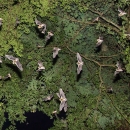About Us
Wheeler National Wildlife Refuge was established on July 7, 1938 by President Franklin D. Roosevelt as a refuge and breeding ground for migratory birds and other wildlife. It was the first refuge ever superimposed on a hydro-electric impoundment and in the early stages, considered an experiment to determine the possibility of attracting migratory waterfowl onto a multipurpose impoundment.
Although designated as a waterfowl refuge, the 35,000 acre refuge provides for a wide spectrum of wildlife. Its great diversity of habitat includes deep river channels, tributary creeks, tupelo swamps, open backwater embayments, bottomland hardwoods, pine uplands, and agricultural fields. This rich mix of habitats provide places for over 295 bird species to rest, nest and winter, including over 30 species of waterfowl and an increasing population of Sandhill cranes and a small number of Whooping cranes.
The refuge is also home to 115 species of fish, 74 species of reptiles and amphibians, 47 species of mammals, 38 species of freshwater mussels, and 26 species of freshwater snails. Other animals such as the endangered Gray bat and Whooping crane benefit from the protection of the National Wildlife Refuge System, and the care of dedicated refuge staff and other friends of wildlife, like you.
Our Mission
The Wheeler National Wildlife Refuge Complex will protect, manage, and, where appropriate, restore native systems of lands and waters to provide habitat for wildlife, fisheries, and plants within northern Alabama for the benefit and enjoyment of present and future generations of Americans. In addition, the Complex will seek partnerships that promote environmental stewardship on non-refuge lands, foster research opportunities to enhance resource management and restoration efforts in the Lower Tennessee-Cumberland Ecosystem, and protect historical and cultural resources of the Complex. When compatible, wildlife-dependent recreational opportunities for hunting, fishing, wildlife observation, wildlife photography, and environmental education and interpretation will be provided, while promoting the public’s understanding of the purposes of refuges in the Wheeler Complex and the mission of the National Wildlife Refuge System.
Other Facilities in this Complex
Wheeler National Wildlife Refuge is managed as part of the Wheeler Complex.




